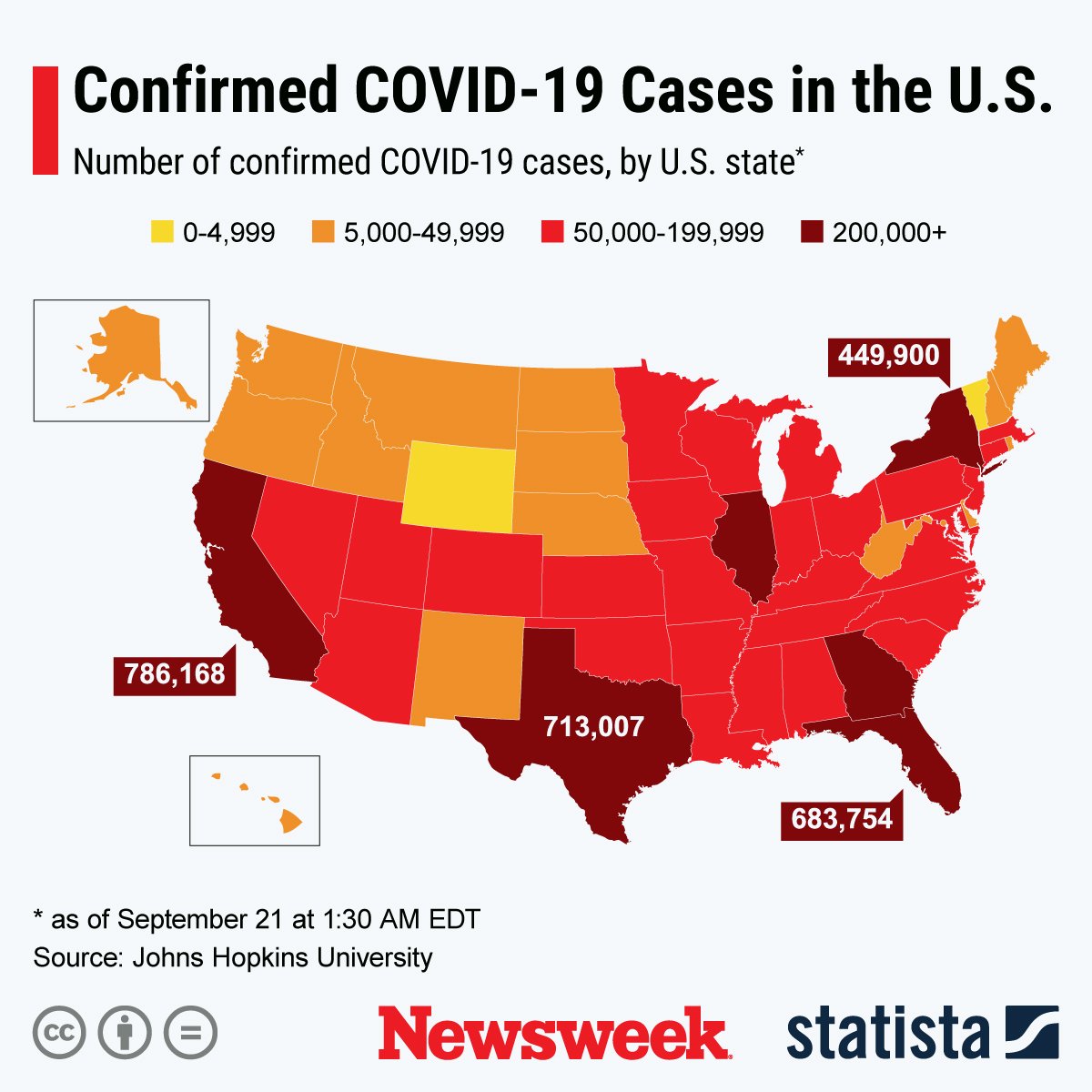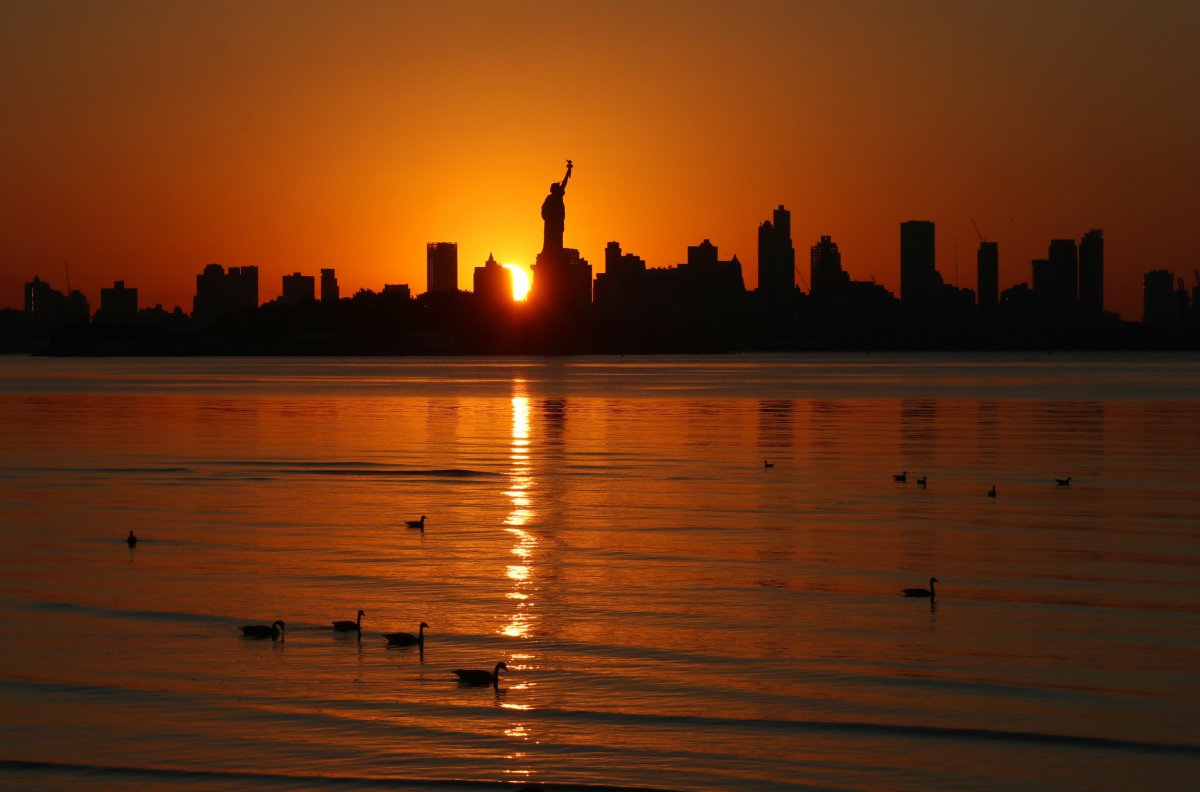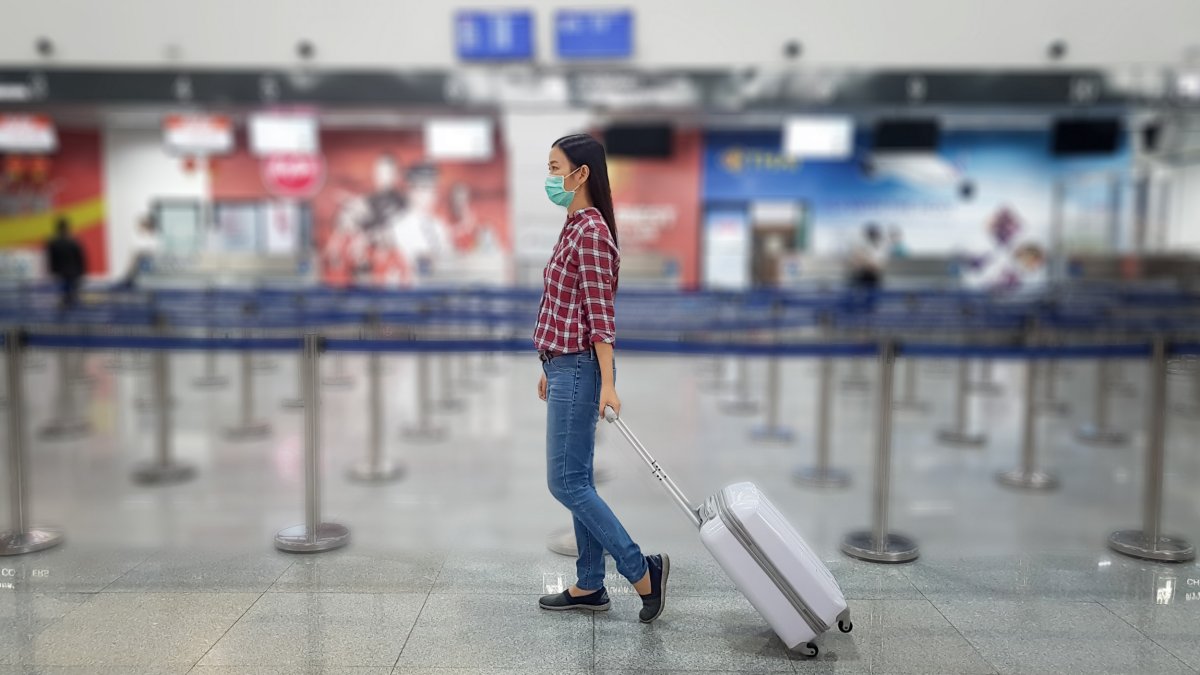As the number of coronavirus cases continues to grow in the U.S., Newsweek takes a look at the current travel restrictions for each state.
At the time of writing, the U.S. has 6,814,696 confirmed cases, with India and Brazil having the second and third highest case numbers respectively, as shown in the below graphic.
The U.S. has confirmed 199,531 deaths from the coronavirus (COVID-19), with 2,590,671 confirmed recoveries. According to Johns Hopkins University's coronavirus map, New York, New Jersey and Texas have the highest numbers of deaths respectively.
This graphic, produced by Statista, illustrates the number of COVID-19 cases recorded in each state.

Can You Spread COVID-19 by Traveling?
According to the Centers for Disease Control and Prevention, travel can increase a person's chance of getting and spreading the coronavirus. While some people might not get any symptoms, also known as being asymptomatic, during traveling they can still spread the virus to others. CDC advises that staying at home is the best way to protect everyone from COVID-19.
"You and your travel companions (including children) may spread COVID-19 to other people including your family, friends, and community for 14 days after you were exposed to the virus," CDC has warned on its website. "Don't travel if you are sick or if you have been around someone with COVID-19 in the past 14 days."
The organization has created the below guidance on what people should do prior, during and post travel.
Before traveling, CDC advises to consider the following:
- Is COVID-19 spreading at your destination? The more cases at your destination, the more likely you are to get infected during travel and spread the virus to others when you return.
- Make sure to check each U.S. state's cases in the last seven days so you can properly prepare.
- If you are planning to travel abroad, read the following recommendations for destinations around the world
- Do you live with someone who might be at increased risk for severe illness from COVID-19? Keep in mind that if you get infected while traveling, you can spread the virus to loved ones when you return.
- Are you at increased risk for severe illness from COVID-19?
- Anyone can get very ill from the virus that causes COVID-19, but older adults and people of any age with certain underlying medical conditions are at increased risk for severe illness from COVID-19.
- Does your destination have requirements or restrictions for travelers?
- Some state, local, and territorial governments have requirements, such as requiring people to wear masks and requiring those who recently traveled to stay home for up to 14 days. Check state, territorial, tribal and local public health websites for information before you travel.
- If you are traveling internationally, check the destination's Office of Foreign Affairs or Ministry of Health or the U.S. Department of State, Bureau of Consular Affairs, Country Information for details about entry requirements and restrictions for arriving travelers, such as mandatory testing or quarantine.
During your trip, take steps to protect yourself and others from COVID-19:
- Wear a mask to keep your nose and mouth covered when in public settings.
- Avoid close contact by staying at least 6 feet apart from anyone who is not from your household.
- Wash your hands often or use hand sanitizer (containing at least 60 percent alcohol).
- Avoid contact with anyone who is sick.
- Avoid touching your eyes, nose and mouth.
According to CDC, airports, bus stations, train stations, and rest stops are all places travelers can be exposed to the virus. This is because the virus is airborne and can travel through droplets in the air and can survive on surfaces. Further, social distancing is more difficult in these areas.
"Air travel requires spending time in security lines and airport terminals, which can bring you in close contact with other people and frequently touched surfaces," says the CDC website. However, it also advises that most viruses and other germs do not spread easily on flights because of how air circulates and is filtered on airplanes.
If you are traveling to the airport on a bus or train, you might be exposed to the virus due to being within 6 feet of others. In a car, stops along the way for gas, food or bathroom breaks can also put you in close contact with others.
Motor homes, also known as RVs, could allow for fewer stops for food and bathroom breaks. However, consider the risk posed by staying overnight at RV parks or other public places. Traveling on a cruise ship or river boat is considered a "high risk" travel situation, according to the CDC.

Which States Have COVID-19 Travel Restrictions?
Different U.S. states have different rules when it comes to state-by-state travel. Some have reopened to travelers, while others are closing up again. Here is a list of each state and its travel status. (All information correct at the time of writing).
Alabama: There are no travel restrictions in places for out-of-state travelers. The updated "Safer at Home" order, which lasts until October 2, 2020, can be found here.
Alaska: This state reopened on September 3, 2020, following restrictions beginning August 11. According to the Alaska COVID-19 website, all non-residents must arrive with a qualifying negative COVID-19 test taken within 72 hours prior to departure or proof of a pending test result from a test taken within 72 hours prior to departure.
Arizona: While some businesses remain closed due to the coronavirus, there are no travel restrictions in place as of September 2020, according to the Arizona Office of Tourism.
Arkansas:This state is now open for travelers from other states. According to the Arkansas website, "effective July 20, 2020, Governor Asa Hutchinson has issued a mandatory mask mandate for residents and visitors in Arkansas."
California: Following a surge in confirmed cases, this state has restricted movement within the state except for errands and urgent matters. According to the state website, residents can travel for "urgent matters or if such travel is essential to your permitted work."
Businesses around the state are opening up but the state government advises people do not travel long distances for vacations or pleasure. This is to slow the spread of the coronavirus. Residents should not travel if they are sick, or if someone in their household has had coronavirus in the last two weeks.
For out of state travelers, there are no restrictions for entering the state.
Colorado: The state is in "Phase Safer at Home in the Vast, Great Outdoors" and welcomes visitors into the state. The government website requests that residents and visitors adhere to social distancing guidelines.
Connecticut: According to the state government's website, as of September 22, 2020, anyone traveling into Connecticut from a state with a positive case rate higher than 10 per 100,000 residents or higher than a 10 percent test positivity rate over a seven-day rolling average are directed to self-quarantine for a 14-day period from the time of last contact within the identified state.
Delaware: A ban on short term rentals was lifted on June 1, however the next phase to reopen the state has been paused. It is currently in the second phase of its plan, according to the travel advisory by Visit Delaware.
District of Columbia: Reopened on August 27, 2020. On September 21, 2020, there was an announcement from the Mayor Bowser further updating that anyone travelling to D.C. from a "high-risk state" within the prior 14 days (from September 21) will be required to self-isolate for 14 days from their arrival into the district if their journey is non-essential.
For those making essential travel, they are asked to self-monitor for symptoms of the coronavirus for 14 days from their arrival. If they show signs or experience symptoms of COVID-19, they need to then self-quarantine and seek medical advice or testing. 7
The full announcement can be read here.
Florida: No restrictions, according to the Florida COVID-19 website.
Georgia: This state reopened on August 27, 2020. All Georgians and visitors are strongly encouraged to wear face coverings in public and practice social distancing, according to Explore Georgia.
Hawaii: All individuals, both residents and visitors, arriving from out-of-state to Hawaii are still subject to a mandatory 14-day self-quarantine. The state's "Pre-Travel Testing Program" is scheduled to begin on October 15, 2020, says the Hawaii Tourism Authority.
Travelers who, upon entry into the state, provide written confirmation from a state approved COVID-19 testing facility of a negative test result from a test administered to the traveler within 72 hours from the final leg of departure, will be exempt from the 14-day mandatory quarantine.
Idaho: According to Visit Idaho, the state, with the exception of Ada County, is currently in Reopening Stage 4. Idaho will remain in Stage 4 until all health and safety criteria and requirements addressed in the protocols have been met. For more information please review the Governor's Guidelines for Opening Up Idaho.
Illinois: As of September 22, 2020, travelers from the following states and territories should quarantine upon arrival in Chicago: Alabama, Arkansas, Georgia, Idaho, Iowa, Kansas, Minnesota, Mississippi, Missouri, Montana, Nebraska, North Dakota, Oklahoma, Puerto Rico, South Carolina, South Dakota, Tennessee, Utah, and Wisconsin. Check local county advisories for travel restrictions.
Indiana: There are no restrictions in place for visitors from other states. The state is currently in phase 4.5 of its reopening plan.
Iowa: The latest information for this state, specifically for visitors, can be found on Travel Iowa. Anyone over the age of two in the state are urged to wear face coverings unless for health reasons or because of a disability.
Kansas: Travellers from certain states may need to quarntine—the list of state is updated every two weeks, according to the Kansas COVID website.
Those who have traveled to the following locations need to quarantine for 14 days after arrival in Kansas. This applies to both Kansas residents and those visiting Kansas:
- Attended/traveled to mass gathering events out-of-state of 500 people or greater where individuals do not socially distance (6 feet) and wear masks.
- Others needing to continue quarantining:
- Received notification from public health officials (state or local) that you are a close contact of a laboratory-confirmed case of COVID-19
Kentucky: According to the COVID website for the state, on July 20, 2020 the Kentucky Department for Public Health issued a travel advisory with the recommendation of a 14-day self-quarantine for travelers who went to any of the states reporting positive testing rate equal to or greater than 15 percent-of COVID-19 testing.
Louisiana: According to Louisiana Travel, the state has moved into Phase 3 of reopening with a statewide mask mandate still in effect.
Maine: Reopened on August 20, 2020. Visitors entering Maine with proof of a recent negative test result do not have to quarantine upon arrival. Residents of New Hampshire, Vermount, Connecticut, New Jersey, New York and Massachuetts are exempt.
Maryland: The Maryland Office of Tourism says travelers are encouraged to contact all businesses before visiting. There is also a requirement for residents and visitors to wear face coverings over the age of five.
Massachusetts: Those over the age of 18 it an unaccompanied minor must complete and submit the online Massachusetts Travel Form unless the individual meets an exemption below:
- Lower-risk State: This includes individuals coming from a COVID-19 lower-risk state within the United States, listed here.
- Transitory travel: This includes people who are passing through Massachusetts and permits travelers to drive through the State or to connect to their airplane, bus or train, or to stop at a highway rest stop, but this exception extends only so long as is reasonably required for the traveler to complete their transit, make any necessary airplane, bus, or train connection, or make use of travel services such as at a highway rest stop.
- Persons Commuting for Work or School: People who regularly commute, at least weekly, outside of Massachusetts to a fixed place to attend school or work or any person who regularly commutes, at least weekly into Massachusetts to a fixed place to attend school or work; provided that in either case, this exception applies only to and from the person's residence and place of work or school. Workers or students who travel to any place that is not their home state for personal or leisure reasons cannot rely on this exemption.
- Patients Seeking or Receiving Medical Treatment: Patients who are traveling to Massachusetts to seek or receive specialized medical care from a physician located in the Commonwealth and persons accompanying and providing needed support to the patient.
- Military Personnel: Any person who is required to travel to Massachusetts at the order or directive of a Federal or State military authority.
- Workers Providing Critical Infrastructure Services: Workers who enter Massachusetts to perform critical infrastructure functions as specified in Version 3.1 of the listing published by the Federal Cybersecurity and Infrastructure Security Agency are exempt from quarantine while they are commuting to or from or while at work.
If you do not meet one of the exemptions above, you must complete and submit the online Massachusetts Travel Form. Failure to submit a completed Massachusetts Travel Form, when required, or failure to comply with the quarantine requirement, if applicable, may result in a $500 fine per day.
Michigan: Local official tourism websites can provide specific guidelines to desintations in Michigan for travelers. Places across the state are also closing their downtown streets to traffic to create safer, walkable environments that allow visitors and residents to socially distance.
Minnesota: Travelers planning to visit the state can find more information on the official government website.
Mississippi: Information can be found on the government website, however home isolation is mandatory if someone has tested positive for COVID-19 by order of the State Health Officer. If you have been in contact with someone who has COVID-19, quarantine is also important to protect others.
Missouri: Reopened on July 22, 2020. Check local travel orders before traveling to a destination in the state.
Montana: Since June 1, out-of-state travelers arriving in Montana have no longer had to quarantine for 14 days. The state reopened on August 14, 2020.
Nebraska: Only individuals returning to Nebraska from internaltional travel will be required to self-quarantine for 14 days upon arrival. Anyone staying in the state less than 14 is also advised to self-isolate, according to the state's Department of Public Health.
Nevada: There are no travel restrictions in place for out-of-state travelers, however this could change so keep up to date with the state's guidelines.
New Hampshire: Reopened on September 11, 2020. There's more information for out of state visitors here.
New Jersey: No restrictions effective September 11, 2020, however there is a mandatory 14-day quarantine in place for travelers coming to New Jersey from 35 high-risk states, all of which can be found here.
New Mexico: Persons who have arrived in New Mexico from states with a 5 percent positivity rate or greater over a seven-day rolling average or a positive test rate greater than 80 per 1 million residents, must physically separate from others in a residence or place of lodging for at least 14 days from the date of their entry into New Mexico or for the duration of their presence in the state, whichever is shorter.
People who show documentation of a valid negative COVID-19 test taken within the 72 hours before or after entry into New Mexico are exempt from the 14-day quarantine requirement, regardless of the state from which they have traveled.
Persons arriving from states with a 5 percent positivity rate or lower over a 7-day rolling average, or a positive test rate lower than 80 per 1 million residents, are not required to self-quarantine.
New York: Governor Andrew Cuomo issued Executive Order 205, which requires all travelers coming from states with significant rates of transmission of COVID-19 to quarantine for a 14-day period from the time of their last contact.
North Carolina: There are no travel restrictions in place for this state.
North Dakota: Travelers entering North Dakota from international locations or other states with widespread COVID-19 transmission must quarantine immediately for 14 days upon arrival, as per CDC guidelines. The state is fully reopened.
Ohio: Those entering Ohio after travel to states reporting positive testing rates of 15% or higher for COVID-19 are advised to self-quarantine for 14 days, says the government's website.
Oklahoma: People entering the state from an area with substantial community spread, will wear a face covering in all public spaces and limit participating indoor gatherings for 10 to 14 days.
Oregon: The next steps in the reopening plan have been paused but there are no travel restrictions in place. The latest information can be found here.
Pennsylvania: Reopening effective August 17, 2020. Travelers entering Pennsylvania from designated high-risk areas are recommended to self-quarantine for 14 days upon arrival.
Rhode Island: The next stages in the reopening plan have been paused. All travelers entering Rhode Island from designated states with a positivity rate of greater than 5 percent must self-quarantine for 14 days, unless they can provide proof of a negative test result within 72 hours prior to arrival.
South Carolina: There are no restrictions in the state. For the latest travel advice, visit the Department of Health website for the state.
South Dakota: Reopened on July 22, 2020. The state does not have any travel restrictions in place for visitors, according to the government website.
Tennessee: Reopened on August 27, 2020. No travel restrictions are in place but people are advised to follow social distancing measures and wear face coverings.
Texas: Reopened on August 27, 2020, with no restrictions in place.
Utah: Reopening effective August 20, 2020. If visitors are healthy, there are no restrictions in place. For those who believe they have come into contact with someone with COVID-19, they are advised to self-isolate for 14 days, as per CDC guidelines.
Vermont: If you are visiting Vermont you must quarantine for 14 days, once you arrive. You have the option to get a PCR test on or after day seven of quarantine and end your quarantine with a negative test result. These are exceptions to the quarantine requirement:
- Travelers from certain counties with low rates of active cases do not need to quarantine when they arrive in Vermont.
- Essential travel includes travel for personal safety, medical care, care of others, parental shared custody, for food, beverage or medicine, to attend preK-12 school if commuting daily, or for work.
- People who live near the Vermont border and regularly travel to and from a neighboring statemay make day trips to Vermont for work, health care, and other essential needs like groceries or visitation for parental shared custody without quarantining.
Virginia: Reopened on August 27, 2020. There are no restrictions in place for out-of-state travelers, but the state government advises to avoid non-essential domestic travel.
Washington: The next steps in the reopening plan have been paused. There are no travel restrictions in place.
West Virginia: The state has reopened. A statewide indoor face covering requirement is in effect and visitors are encouraged to maintain a safe social distance when traveling the state.
Wisconsin: Some local governments have issued their own orders, but the state is open.
Wyoming: No restrictions effective September 3, 2020, for U.S. domestic travelers.

The information in this article was last updated on 9/24/20, 12:00 p.m. ET.
Correction 9/23/20, 11:58 a.m. ET: This article was updated to state that Arizona and California are open to out of state travelers, but some businesses remain closed. D.C. has also been updated to reflect the latest announcement from the District's Department of Public Health, released on September 21, 2020.
Uncommon Knowledge
Newsweek is committed to challenging conventional wisdom and finding connections in the search for common ground.
Newsweek is committed to challenging conventional wisdom and finding connections in the search for common ground.
About the writer
Sophia Waterfield is a reporter for Newsweek based at its London bureau. She has written for publications such as Metro UK, ... Read more
To read how Newsweek uses AI as a newsroom tool, Click here.








